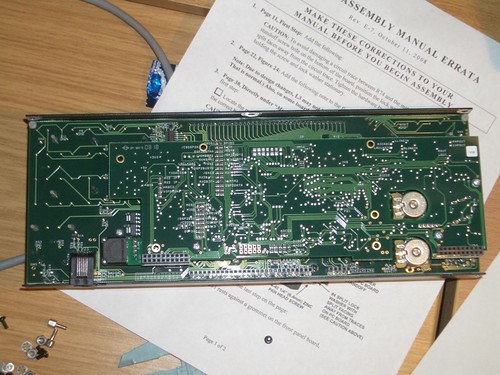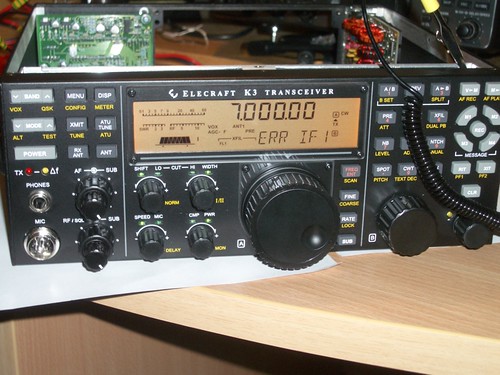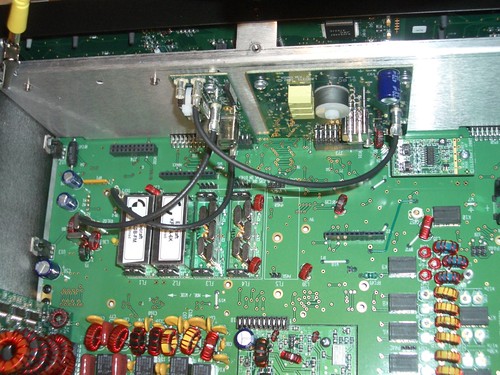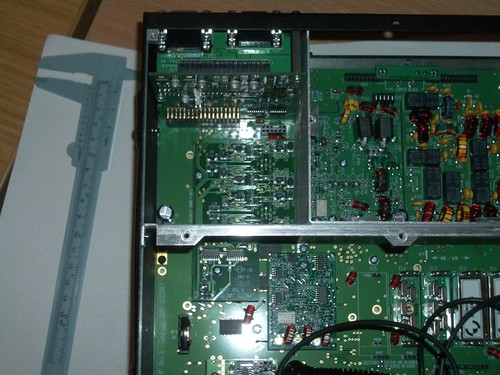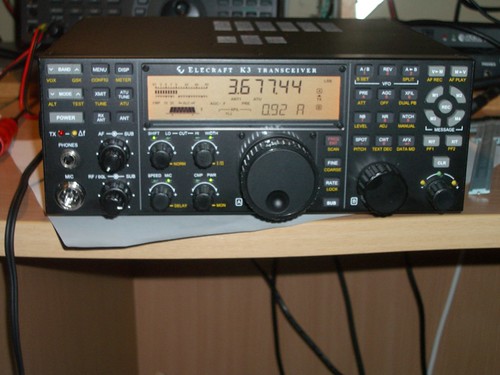I just love that title from Pat Rundell’s weblog (N0HR) so I couldn’t resist using it.
I was asked the other day, how ‘competitiveness’ gets measured, how can there be ‘contests’ on Amateur Radio. It is a good question which I will try and explain a bit better with an example. Below is my log (in Cabrillo format) in the IRTS 80 Meter Counties Contest from the first of January 2009, which I recently received back from Thos, EI2JD, the IRTS contest manager.
The purpose of the contest is to “work” i.e. speak to as many stations in as many Irish counties as possible in the three hour time window between 14:00 and 17:00UTC on the date of the contest. A contact is only considered valid if both operators exchange correctly their callsign, a signal strength report (in contests its always given ‘5’ by ‘9’ no matter what it really is), a serial number, and a county. Scoring is relatively straightforward. For any county in the 32 counties, the contact is worth 4 points, for any contact outside of the 32 counties, the contact is worth 1 point. Then, this total is multiplied by the number of different counties contacted. Make sense?, Right so, lets look at my log.
CLAIMED-SCORE: 2860
CLUB:
CONTEST: IRTS80M
CREATED-BY: YFKtest 0.0.9
NAME:
ADDRESS: 41 qso
ADDRESS: 8 oei = 8
ADDRESS: 33 ei = 132
ADDRESS: 20 co = 140 x 20 = 2800
OPERATORS: EI7IG
SOAPBOX:
QSO: 3500 PH 2009-01-01 1540 EI7IG 59 1 WATERFORD EI3JB 59 049 WAT 4
QSO: 3500 PH 2009-01-01 1542 EI7IG 59 2 WATERFORD EI7GAB 59 051 DON 4
QSO: 3500 PH 2009-01-01 1544 EI7IG 59 3 WATERFORD GM3PAI 59 062 0 GM3POI
QSO: 3500 PH 2009-01-01 1545 EI7IG 59 4 WATERFORD EI7CD 59 071 DUB 4
QSO: 3500 PH 2009-01-01 1548 EI7IG 59 5 WATERFORD EI2GLB 59 081 KLD 4
QSO: 3500 PH 2009-01-01 1551 EI7IG 59 6 WATERFORD EI4GYB 59 125 CAR 4
QSO: 3500 PH 2009-01-01 1551 EI7IG 59 7 WATERFORD EI3JE 59 129 COR 4
QSO: 3500 PH 2009-01-01 1552 EI7IG 59 8 WATERFORD EI8BEB 59 073 SLI 4
QSO: 3500 PH 2009-01-01 1553 EI7IG 59 9 WATERFORD EI4GXB 59 086 CLA 4
QSO: 3500 PH 2009-01-01 1554 EI7IG 59 10 WATERFORD EI6GEB 59 125 LAO 4
QSO: 3500 PH 2009-01-01 1555 EI7IG 59 11 WATERFORD EI6JK 59 112 ROS 4
QSO: 3500 PH 2009-01-01 1556 EI7IG 59 12 WATERFORD EI3ENB 59 036 KLK 4
QSO: 3500 PH 2009-01-01 1558 EI7IG 59 13 WATERFORD EI9DZ 59 038 LEI 4
QSO: 3500 PH 2009-01-01 1600 EI7IG 59 14 WATERFORD EI5GTB 59 062 DON 4
QSO: 3500 PH 2009-01-01 1601 EI7IG 59 15 WATERFORD EI9FBB 59 093 COR 4
QSO: 3500 PH 2009-01-01 1604 EI7IG 59 16 WATERFORD EI6DL 59 045 WES 4
QSO: 3500 PH 2009-01-01 1606 EI7IG 59 17 WATERFORD EI2V 59 080 DUB 4
QSO: 3500 PH 2009-01-01 1607 EI7IG 59 18 WATERFORD EI8CE 59 115 WAT 4
QSO: 3500 PH 2009-01-01 1608 EI7IG 59 19 WATERFORD EI9HX 59 117 ROS 4
QSO: 3500 PH 2009-01-01 1610 EI7IG 59 20 WATERFORD EI4CF 59 088 GAL 4
QSO: 3500 PH 2009-01-01 1611 EI7IG 59 21 WATERFORD EI9JU 59 070 DON 4
QSO: 3500 PH 2009-01-01 1612 EI7IG 59 22 WATERFORD EI5GPB 59 070 COR 4
QSO: 3500 PH 2009-01-01 1613 EI7IG 59 23 WATERFORD EI8JA 59 061 WAT 4
QSO: 3500 PH 2009-01-01 1614 EI7IG 59 24 WATERFORD M0MCX 59 080 1
QSO: 3500 PH 2009-01-01 1620 EI7IG 59 25 WATERFORD EI3GRB 59 084 CLA 4
QSO: 3500 PH 2009-01-01 1621 EI7IG 59 26 WATERFORD GI8SKN 59 097 ANT 4
QSO: 3500 PH 2009-01-01 1622 EI7IG 59 27 WATERFORD EI8IU 59 087 LEI 4
QSO: 3500 PH 2009-01-01 1624 EI7IG 59 28 WATERFORD EI2CA 59 132 MEA 4
QSO: 3500 PH 2009-01-01 1625 EI7IG 59 29 WATERFORD M0DDT 59 058 1
QSO: 3500 PH 2009-01-01 1639 EI7IG 59 30 WATERFORD EI7GY 59 087 DUB 4
QSO: 3500 PH 2009-01-01 1644 EI7IG 59 31 WATERFORD G3WGQ 59 025 1
QSO: 3500 PH 2009-01-01 1645 EI7IG 59 32 WATERFORD MI0CLP/P 59 078 ARM 4
QSO: 3500 PH 2009-01-01 1645 EI7IG 59 33 WATERFORD G3LAS 59 037 1
QSO: 3500 PH 2009-01-01 1646 EI7IG 59 34 WATERFORD G4TPH 59 004 1
QSO: 3500 PH 2009-01-01 1646 EI7IG 59 35 WATERFORD G0MUR 59 011 1
QSO: 3500 PH 2009-01-01 1647 EI7IG 59 36 WATERFORD G3RXQ 59 031 1
QSO: 3500 PH 2009-01-01 1648 EI7IG 59 37 WATERFORD MI3CQX 59 021 DOW 4
QSO: 3500 PH 2009-01-01 1648 EI7IG 59 38 WATERFORD EI9FVB 59 114 COR 4
QSO: 3500 PH 2009-01-01 1649 EI7IG 59 39 WATERFORD MU0FAL 59 037 1
QSO: 3500 PH 2009-01-01 1651 EI7IG 59 40 WATERFORD EI5IH 59 046 CAV 4
QSO: 3500 PH 2009-01-01 1654 EI7IG 59 41 WATERFORD EI1DG 59 045 DUB 4
QSO: 3500 PH 2009-01-01 1657 EI7IG 59 42 WATERFORD EI7MRE 59 093 MAY 4
END-OF-LOG
The first thing you’ll notice is that my claimed score (2860) is higher than the score Thos gave me (2800). I obviously made an error in my calculations, but also notice that I make a mistake in the third QSO. I must no have heard the other station correctly and entered their call-sign incorrectly. Also if you look at the time of my first log entry, you’ll notice that I didn’t actually start until 15:40, the contest was nearly half over by then (I was elsewhere and had to rush back for the contest).
Now, how would I got about improving my score i.e. make my station more competitive? Well there’s a few things I could do. First, getting on air for the entire duration of the contest would be a great help. Next, given as I’m fairly restricted at home in the size of an antenna that I can put up, I’ll probably have to ‘go portable’ for the next contest. Somewhere along the copper coast most likely, which would give me a very good ‘ground’ for an antenna that will allow me to hear and work stations around Ireland much easier. This would then hopefully lead to me hearing more counties, which would increase my number of multipliers (mult count), and thus increase my score. Based on what I heard on air on the day, I’m expecting to see the winning score to be somewhere over 12,000 maybe even higher (150-160 contacts, 31 counties).
Now, to competitiveness. I guess it would go along the lines of beating my own score first, then to try to beat the score of everyone else in the local club/county/province/country. The first one should be easy, the rest, well we’ll just have to see what happens on the Sunday the 21st of June.
73, and see you on the band!
de John, EI7IG

